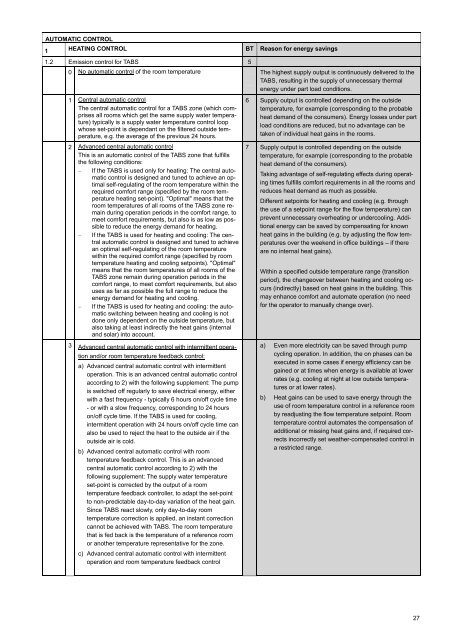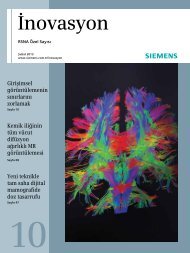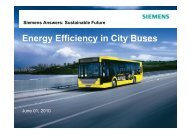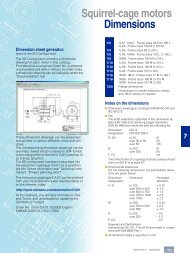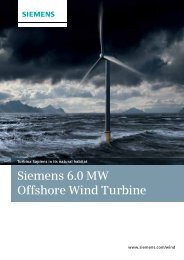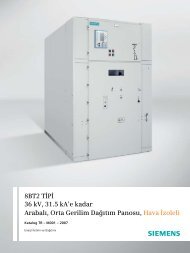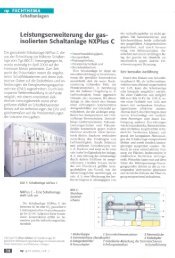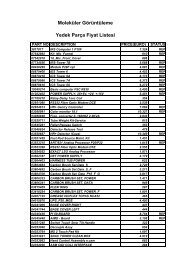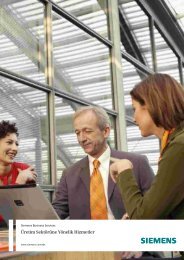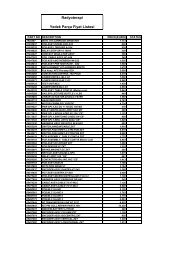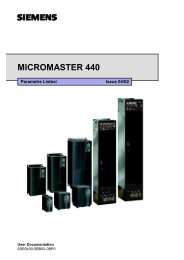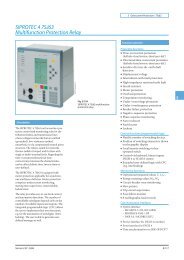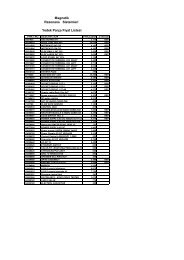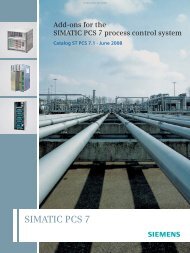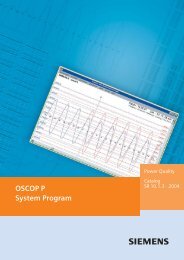Building automation â impact on energy efficiency - Siemens ...
Building automation â impact on energy efficiency - Siemens ...
Building automation â impact on energy efficiency - Siemens ...
Create successful ePaper yourself
Turn your PDF publications into a flip-book with our unique Google optimized e-Paper software.
AUTOMATIC CONTROL<br />
1 HEATING CONTROL BT Reas<strong>on</strong> for <strong>energy</strong> savings<br />
1.2 Emissi<strong>on</strong> c<strong>on</strong>trol for TABS 5<br />
0 No automatic c<strong>on</strong>trol of the room temperature The highest supply output is c<strong>on</strong>tinuously delivered to the<br />
TABS, resulting in the supply of unnecessary thermal<br />
<strong>energy</strong> under part load c<strong>on</strong>diti<strong>on</strong>s.<br />
1 Central automatic c<strong>on</strong>trol<br />
The central automatic c<strong>on</strong>trol for a TABS z<strong>on</strong>e (which comprises<br />
all rooms which get the same supply water temperature)<br />
typically is a supply water temperature c<strong>on</strong>trol loop<br />
whose set-point is dependant <strong>on</strong> the filtered outside temperature,<br />
e.g. the average of the previous 24 hours.<br />
2 Advanced central automatic c<strong>on</strong>trol<br />
This is an automatic c<strong>on</strong>trol of the TABS z<strong>on</strong>e that fulfills<br />
the following c<strong>on</strong>diti<strong>on</strong>s:<br />
– If the TABS is used <strong>on</strong>ly for heating: The central automatic<br />
c<strong>on</strong>trol is designed and tuned to achieve an optimal<br />
self-regulating of the room temperature within the<br />
required comfort range (specified by the room temperature<br />
heating set-point). "Optimal" means that the<br />
room temperatures of all rooms of the TABS z<strong>on</strong>e remain<br />
during operati<strong>on</strong> periods in the comfort range, to<br />
meet comfort requirements, but also is as low as possible<br />
to reduce the <strong>energy</strong> demand for heating.<br />
– If the TABS is used for heating and cooling: The central<br />
automatic c<strong>on</strong>trol is designed and tuned to achieve<br />
an optimal self-regulating of the room temperature<br />
within the required comfort range (specified by room<br />
temperature heating and cooling setpoints). "Optimal"<br />
means that the room temperatures of all rooms of the<br />
TABS z<strong>on</strong>e remain during operati<strong>on</strong> periods in the<br />
comfort range, to meet comfort requirements, but also<br />
uses as far as possible the full range to reduce the<br />
<strong>energy</strong> demand for heating and cooling.<br />
– If the TABS is used for heating and cooling: the automatic<br />
switching between heating and cooling is not<br />
d<strong>on</strong>e <strong>on</strong>ly dependent <strong>on</strong> the outside temperature, but<br />
also taking at least indirectly the heat gains (internal<br />
and solar) into account.<br />
3 Advanced central automatic c<strong>on</strong>trol with intermittent operati<strong>on</strong><br />
and/or room temperature feedback c<strong>on</strong>trol:<br />
a) Advanced central automatic c<strong>on</strong>trol with intermittent<br />
operati<strong>on</strong>. This is an advanced central automatic c<strong>on</strong>trol<br />
according to 2) with the following supplement: The pump<br />
is switched off regularly to save electrical <strong>energy</strong>, either<br />
with a fast frequency - typically 6 hours <strong>on</strong>/off cycle time<br />
- or with a slow frequency, corresp<strong>on</strong>ding to 24 hours<br />
<strong>on</strong>/off cycle time. If the TABS is used for cooling,<br />
intermittent operati<strong>on</strong> with 24 hours <strong>on</strong>/off cycle time can<br />
also be used to reject the heat to the outside air if the<br />
outside air is cold.<br />
b) Advanced central automatic c<strong>on</strong>trol with room<br />
temperature feedback c<strong>on</strong>trol. This is an advanced<br />
central automatic c<strong>on</strong>trol according to 2) with the<br />
following supplement: The supply water temperature<br />
set-point is corrected by the output of a room<br />
temperature feedback c<strong>on</strong>troller, to adapt the set-point<br />
to n<strong>on</strong>-predictable day-to-day variati<strong>on</strong> of the heat gain.<br />
Since TABS react slowly, <strong>on</strong>ly day-to-day room<br />
temperature correcti<strong>on</strong> is applied, an instant correcti<strong>on</strong><br />
cannot be achieved with TABS. The room temperature<br />
that is fed back is the temperature of a reference room<br />
or another temperature representative for the z<strong>on</strong>e.<br />
c) Advanced central automatic c<strong>on</strong>trol with intermittent<br />
operati<strong>on</strong> and room temperature feedback c<strong>on</strong>trol<br />
6 Supply output is c<strong>on</strong>trolled depending <strong>on</strong> the outside<br />
temperature, for example (corresp<strong>on</strong>ding to the probable<br />
heat demand of the c<strong>on</strong>sumers). Energy losses under part<br />
load c<strong>on</strong>diti<strong>on</strong>s are reduced, but no advantage can be<br />
taken of individual heat gains in the rooms.<br />
7 Supply output is c<strong>on</strong>trolled depending <strong>on</strong> the outside<br />
temperature, for example (corresp<strong>on</strong>ding to the probable<br />
heat demand of the c<strong>on</strong>sumers).<br />
Taking advantage of self-regulating effects during operating<br />
times fulfills comfort requirements in all the rooms and<br />
reduces heat demand as much as possible.<br />
Different setpoints for heating and cooling (e.g. through<br />
the use of a setpoint range for the flow temperature) can<br />
prevent unnecessary overheating or undercooling. Additi<strong>on</strong>al<br />
<strong>energy</strong> can be saved by compensating for known<br />
heat gains in the building (e.g. by adjusting the flow temperatures<br />
over the weekend in office buildings – if there<br />
are no internal heat gains).<br />
Within a specified outside temperature range (transiti<strong>on</strong><br />
period), the changeover between heating and cooling occurs<br />
(indirectly) based <strong>on</strong> heat gains in the building. This<br />
may enhance comfort and automate operati<strong>on</strong> (no need<br />
for the operator to manually change over).<br />
a) Even more electricity can be saved through pump<br />
cycling operati<strong>on</strong>. In additi<strong>on</strong>, the <strong>on</strong> phases can be<br />
executed in some cases if <strong>energy</strong> <strong>efficiency</strong> can be<br />
gained or at times when <strong>energy</strong> is available at lower<br />
rates (e.g. cooling at night at low outside temperatures<br />
or at lower rates).<br />
b) Heat gains can be used to save <strong>energy</strong> through the<br />
use of room temperature c<strong>on</strong>trol in a reference room<br />
by readjusting the flow temperature setpoint. Room<br />
temperature c<strong>on</strong>trol automates the compensati<strong>on</strong> of<br />
additi<strong>on</strong>al or missing heat gains and, if required corrects<br />
incorrectly set weather-compensated c<strong>on</strong>trol in<br />
a restricted range.<br />
27


